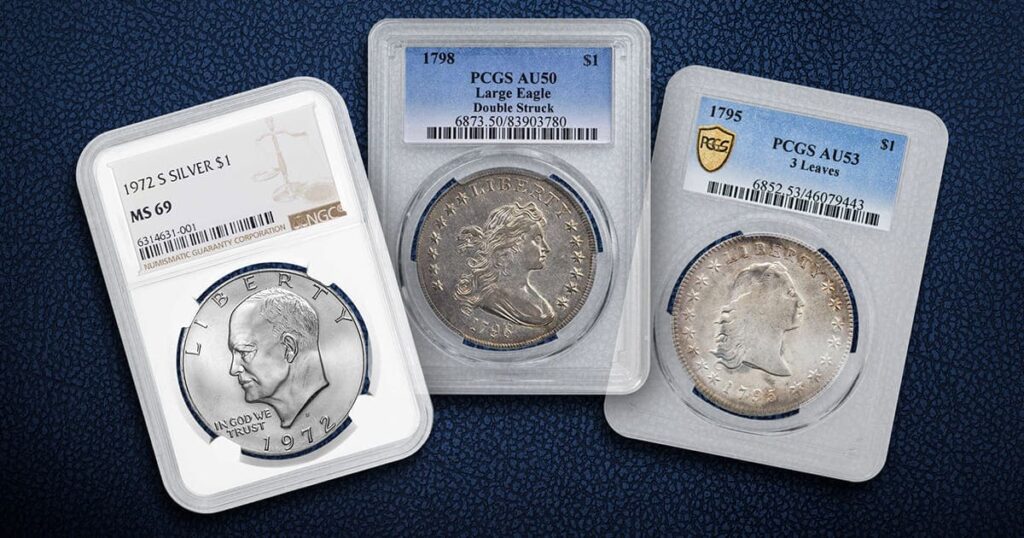
People often ask us what their silver dollar is worth. But it is a difficult question to answer accurately without more information. American Silver Dollars are some of the most popular coins in the world. They are the largest, heaviest circulating silver coins in our history.
The Coinage Act of April 2, 1792 founded the building of a United States Mint to regulate and establish a coinage within the United States. Regarding this coinage, the U.S. Mint was to strike Half Cents and Cents in copper, Half Dimes, Dimes, Quarter Dollars, Half Dollars, and Silver Dollars – all in silver. There would also be struck the following denominations in gold – Quarter Eagles ($2.50 face value), Half Eagles ($5.00), and Eagles ($10.00).
Of course, since this was a new operation, the mintage for these coins could have been much higher. For a more current example, the 3 U.S. mint locations struck about 8.5 billion 2021-dated Lincoln pennies. In 1794, the sole U.S. Mint in Philadelphia struck only 1,758 of the 1794-dated silver dollars.
Flowing Hair Silver Dollars
The first series of silver dollars are known as Flowing Hair Silver Dollars. The designer, Robert Scot, depicted an allegorical representation of Miss Liberty with wild, flowing hair – hence the Flowing Hair nickname. Struck in 1794 and 1795, the coins received numerous complaints about the “terrifying looking Miss Liberty” on the obverse led to the first design change in U.S. coin history.
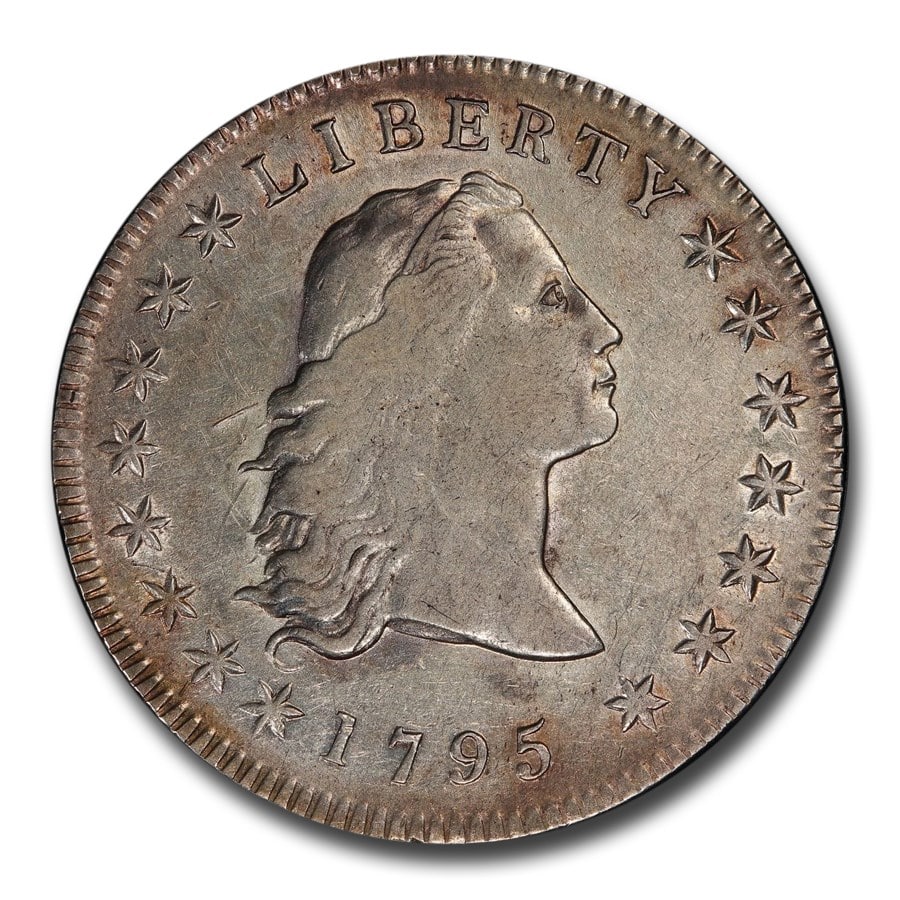

(A 1795 Flowing Hair Silver Dollar – Obverse [left], Reverse [right].)
Scot, again, redesigned Miss Liberty. Her hair was much neater, and she didn’t have a terrifying appearance. Her hair was no longer flying in the strong winds. She was much more dignified and had a stately appearance.
Now the attention of the critics of the designs of our silver dollars turned their attention to the reverse. As mandated by Congress, the reverse depicted an American Bald Eagle. But the eagle looked “scrawny” and undignified. Compared to the majestic and imposing eagles on silver coins of Germany, Austria-Hungary, and Russia, it was indeed weak looking. This scrawny eagle only survived from 1795 through 1798.
So, Scot returned to work, and his finished product was quite a change. This design has been called the “Heraldic Eagle.” This design depicted: a majestic eagle with wings raised and outstretched, an American Shield covering its body, as the eagle held arrows in one talon (expressing readiness for war) and an olive branch in the other (representing our desire for peace), and thirteen six-pointed stars representing the original colonies. This design readily appeased most critics.
This updated design was struck between 1798 and 1804. The 1804-dated coins are now commonly considered the “King of United States coins.” They were struck in 1834 or 1835 in very limited numbers to be given as proof coin sets to Asian leaders.
Today, only approximately 15 specimens are known to exist. Whenever one of these coins comes up for auction, it is truly a newsworthy numismatic event. The 1794 Flowing Hair Dollar is rare in all grades, while the 1795 starts at around $3,000.00 for a well-circulated specimen.
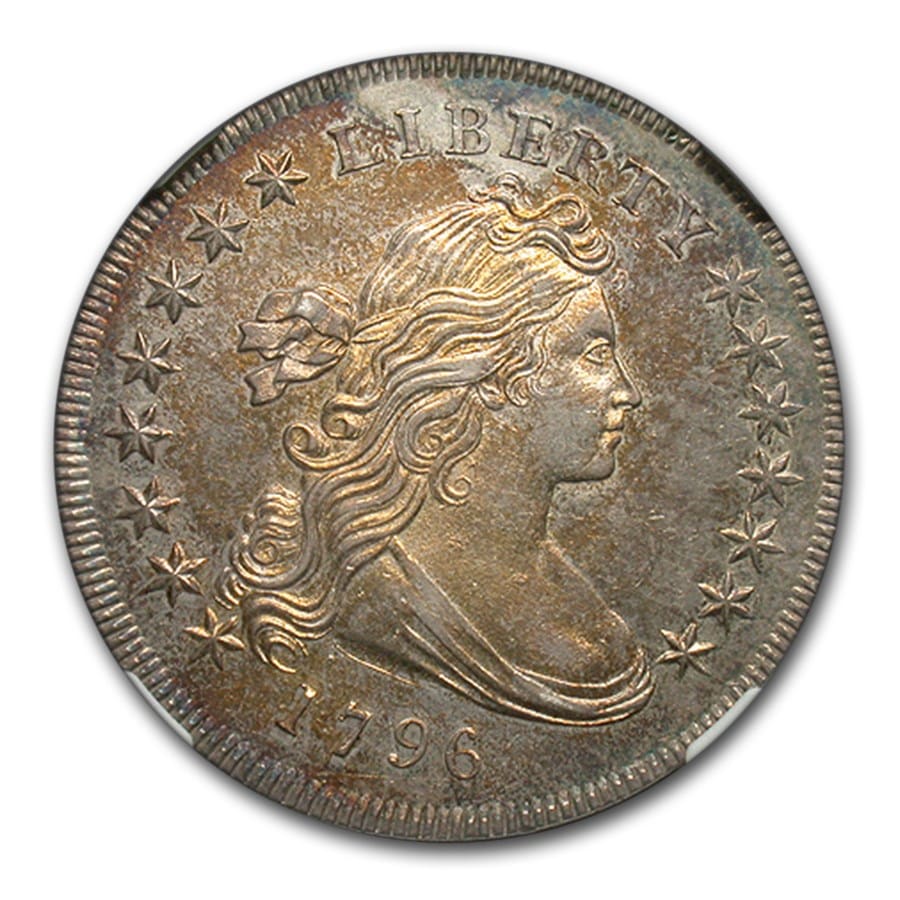

(A 1796 Draped Bust Dollar, with the still Scrawny Eagle, Obverse [left], Reverse [right].)
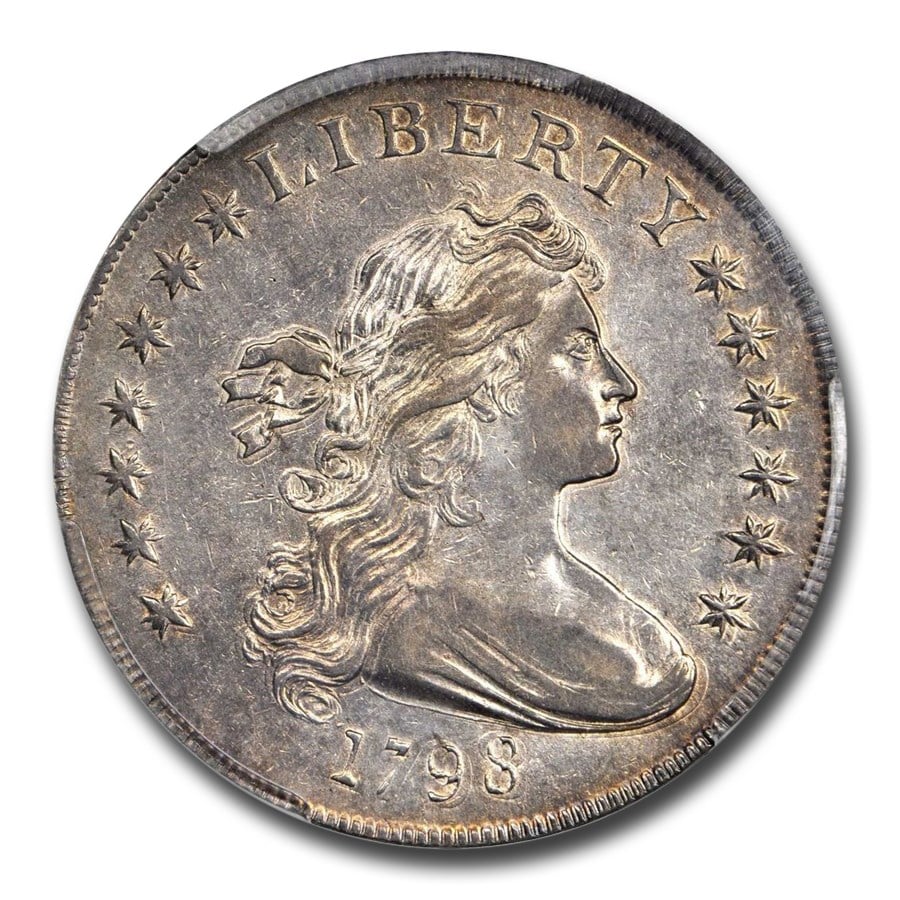

(A 1798 Silver Dollar, Draped Bust with Heraldic Eagle reverse. Obverse [left], Reverse [right].)
A little more than 1.4 million silver dollars of all design types were struck between 1794 and 1804. No further coins were struck until 1836, when the then-Chief Engraver of the United States Mint, Christian Gobrecht, was instructed to create a new design. In the early 19th century, silver dollar coins were not actually needed as their buying power was so great. But as silver prices and the prices for goods increased, so did the demand for silver coins – including the large silver dollar coin.
In addition, this large silver coin was again being used in international trade with numerous European countries, so its American counterpart had to approximate these other coins in size and weight.
Heraldic Eagle Silver Dollars start around $1,500 for a well-circulated specimen.
Gobrecht Silver Dollars
Christian Gobrecht was the Chief Engraver of the U.S. Mint during the 1840s, but during the 1830s, he held the title of Second Engraver. Because the Chief Engraver, William Kneass suffered a stroke, Gobrecht was called upon to design many different coins.
Since no silver dollars had been struck since the 1804-dated special coins, U.S. commerce needed large silver coins. In 1835, a new Director of the Mint, Robert Patterson, attempted to redesign the nation’s coinage. Artist Thomas Sully of Philadelphia sketched a rough design, as did Titian Peale. Sully designed an obverse bearing Liberty, while Peale designed an eagle reverse. Sully and Peale’s rough designs were brought to life by Christian Gobrecht.
By 1836, working dies of the designs had been created and production of the coins began. After releasing some of the coins, the U.S. Mint started receiving complaints about Gobrecht’s signature being too prominent on the coins. During the period 1836 through 1839, only about 1,900 Gobrecht Dollars were struck. Due to these extremely low mintages, Gobrecht Dollars are considered more like Pattern coins rather than circulating issues. As such, even single examples are considered relatively scarce and missing from most collections.
Gobrecht Silver Dollars are extremely rare in all grades – a Very Fine example starts at around $15,000.00.
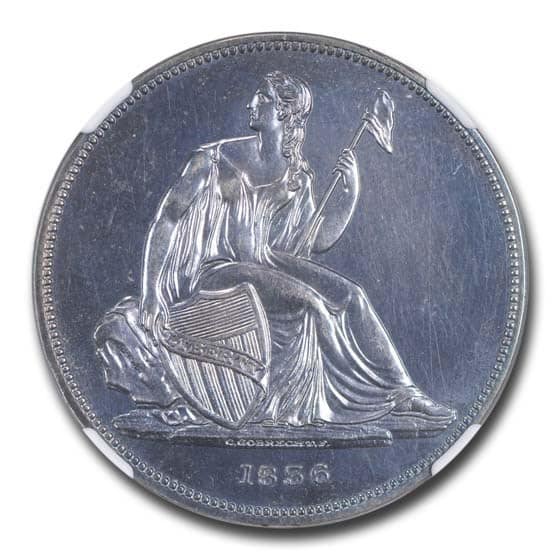
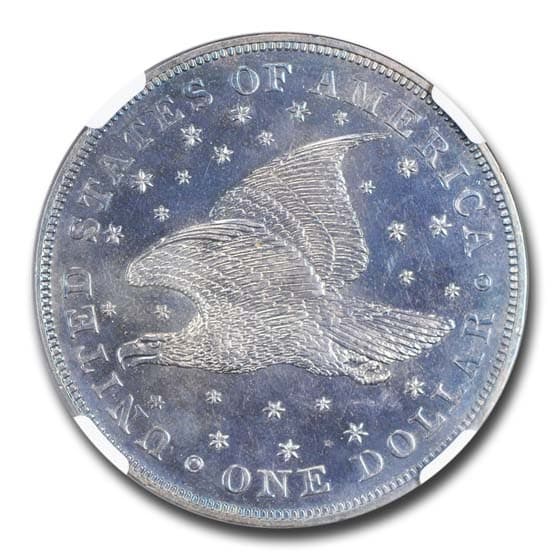
(An 1836 Gobrecht Silver Dollar, in Proof, Obverse [left], Reverse [right].)
Seated Liberty Silver Dollars
Christian Gobrecht was now the Chief Engraver at the U.S. Mint. His “Gobrecht Dollars” had been struck to determine acceptance by the public of a large silver coin once again. The public’s reaction was so positive that the Mint purchased new engraving equipment, allowing them to create more dies by machine instead of by hand. Due to the high popularity, Gobrecht re-engraved the obverse design, modified the reverse design, and created a new coin – the Seated Liberty Silver Dollar.
These Seated Liberty coins were to become the backbone of commerce for the country, especially in the Midwest and the Western states. These coins, similar to British coinage, were now struck in sufficient quantities, providing commerce with abundant coins. They also were in demand in other countries in Europe and Asia.
The series was struck from 1840 until 1873 until the production of silver dollar coins was halted by the Act of 1873. While this Act also provided for a new silver dollar coin, larger in size, to be struck for export. The Act was short-lived as Western mining interests, farmers, and politicians all gathered to create the Bland-Allison Act of 1878. The Bland-Allison Act created a massive amount of the most popular silver dollar coin in our history – the Morgan Silver Dollar.
Seated Liberty Silver Dollars start at $500.00 and rise to an About Uncirculated coin at $2,000.00.
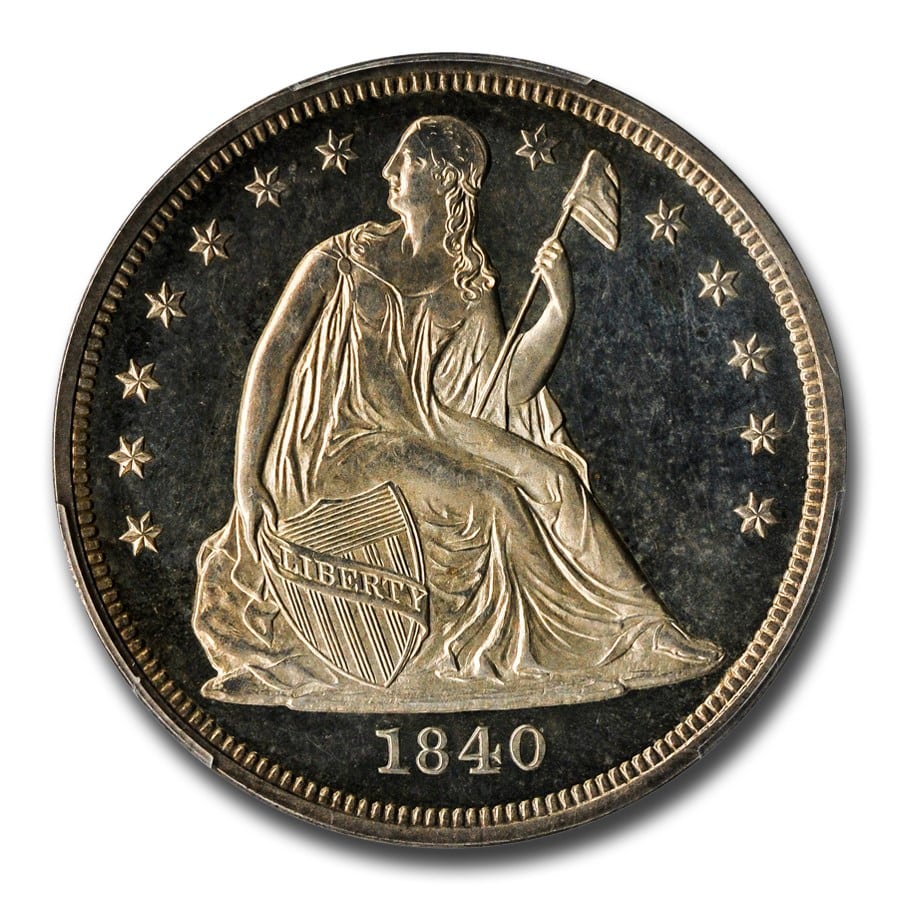
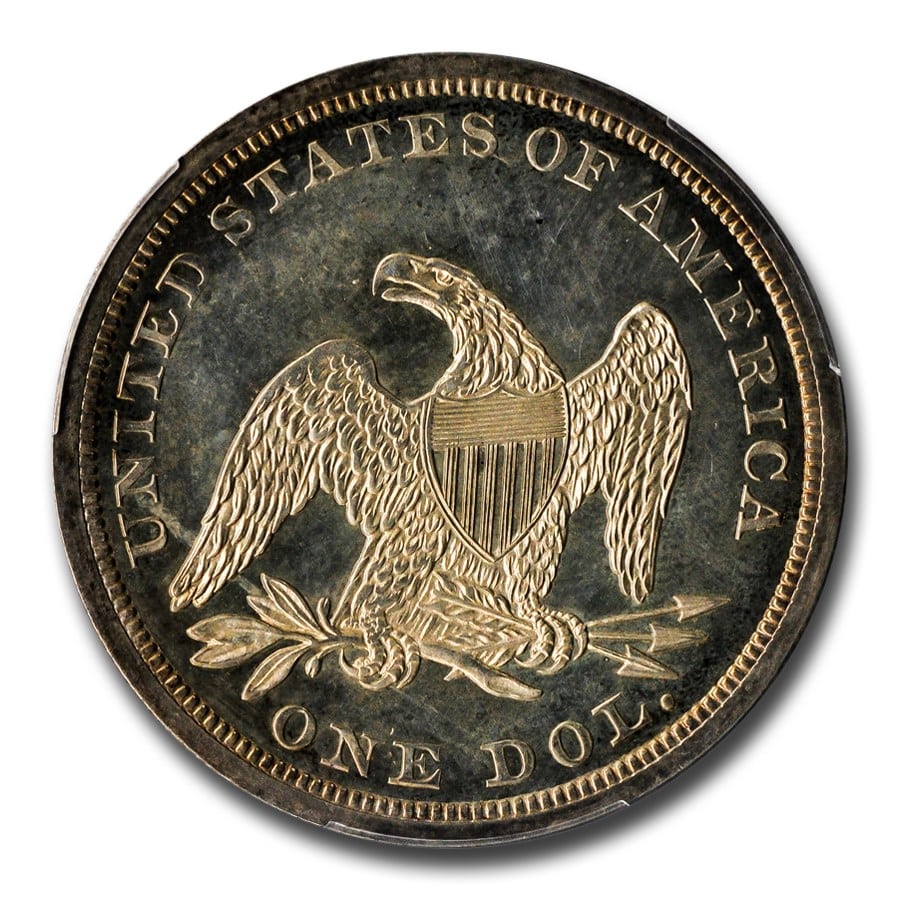
(An 1840 Seated Liberty Dollar, in Proof, Obverse[left], Reverse [right].)
Trade Silver Dollars
The Coinage Act of 1873 ended the striking of the Seated Liberty Dollar series. But from that Act came a new coin to export to Asia, where many Seated Liberty Dollars wound up anyway. The new coins would compete with the Mexican 8 Reales silver coin in Asia.
Chief Engraver William Barber designed the coin, which depicted a left-facing allegorical depiction of Miss Liberty, seated, holding an olive branch over the sea. The reverse depicted a large eagle holding arrows in one talon and an olive branch in the other. Below the eagle is the weight and fineness of the coin to make trade easy.
These coins were well distributed in the United States by one of the provisions of the Act of 1873. Trade Dollars were only legal tender in the U.S. in groups of five or fewer coins to encourage their international trade, where all dollar amounts were taken at face value.
Thousands of these coins were shipped to China for trade and were extremely popular. Many merchants would strike these Trade Dollars with small punches bearing Chinese characters. These are called “chop marks” and, for many decades, were shunned by dealers, collectors and the public in general. These chop-marked coins were considered damaged. The grading services wouldn’t grade these coins. But after several years, the history of these coins and the Chinese marks themselves were considered part of the coins’ history.
Today, chop-marked Trade Dollars are welcome in the hobby. Dealers like them, collectors buy them, and grading services will certify them. The prices of these coins buoyed as people began to realize the true history and the various long-distance travels of these coins.
Common date Trade Dollars start at $300.00 in low grade and rise to nearly $2,000.00 for a better About Uncirculated coin.
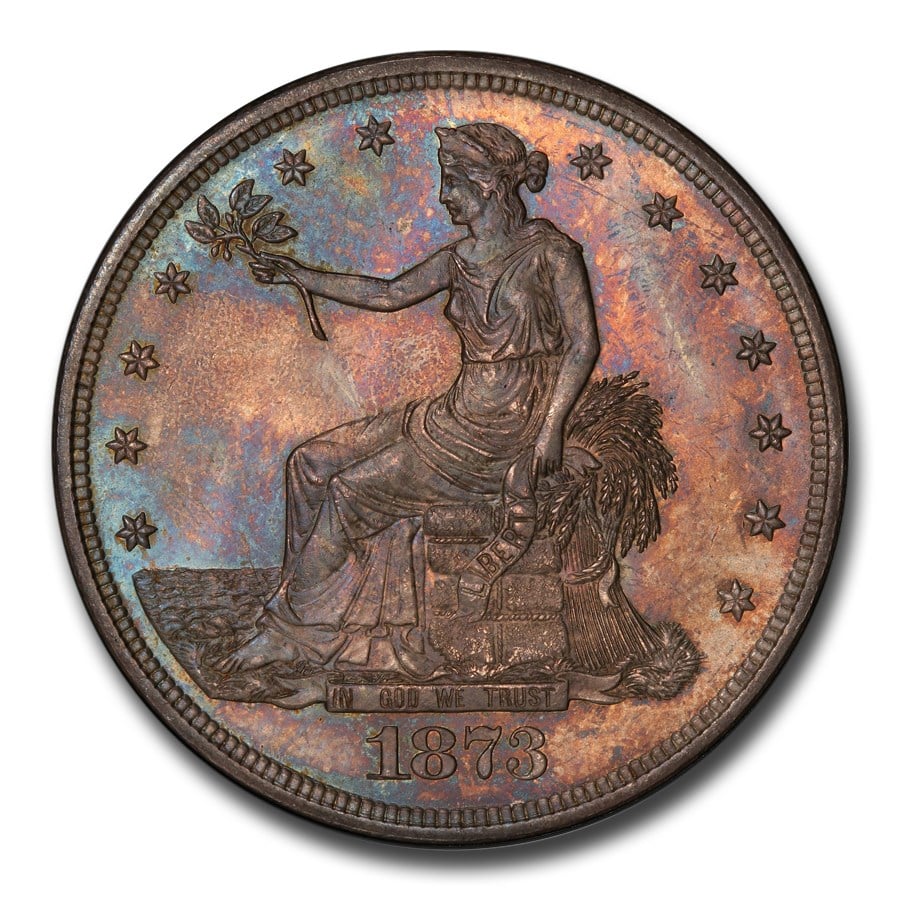
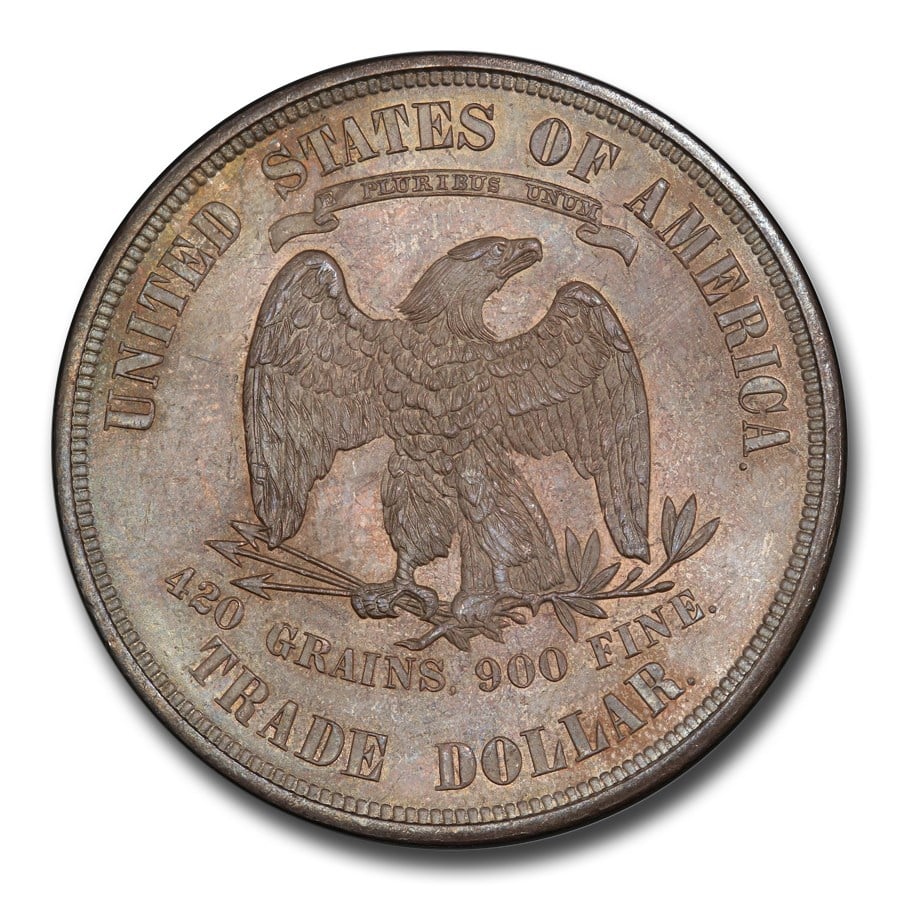
(An 1873 Trade Dollar, Mint State, Obverse [left], Reverse [right].)
Morgan Silver Dollars
The Bland-Allison Act of 1878 was fostered by the joint efforts of western mining interests, farmers, and politicians. With the Comstock Lode and other silver finds being discovered in the West, these people convinced a majority of Congressmen that this Act would bring great prosperity to the Western States.
The Treasury of the United States was now obligated to purchase up to two million dollars of Western silver each month, and that silver was to be minted into silver dollars. William Barber proposed several designs, but his assistant, George T. Morgan, provided an approved and generally well-liked design.
Morgan designed a coin with the head of Miss Liberty on the obverse, facing right, wearing a crown of wheat, corn, and cotton with the word “LIBERTY,” while the reverse depicted a majestic-looking eagle. Due to the Bland-Allison Act’s requirements, millions and millions of these coins were struck.
Not only were hundreds of millions of these coins struck at the main Mint in Philadelphia and the local Mint in Carson City, but hundreds of millions of coins were also struck in New Orleans and San Francisco. These coins, for the most part, were struck in large quantities – but several dates struck in the low hundreds of thousands or less became this series’ rare dates.
The coins were struck between 1878 and 1904 at various Mints throughout that long 27-year run. But the coins were piling up by the bag-full in the Mints and the Treasury Department. There was a long hiatus when production stopped in 1904 and didn’t re-start until 1921. When production resumed, the Mint no longer had the dies from the 1904 dates coins, so a now elderly George T. Morgan, at the end of his career, had to recreate dies for these coins to be struck again in 1921.
The coins were re-struck in 1921 because the U.S. Government had melted 270 million of these “unused” silver dollars and then sold the corresponding silver to Great Britain. They were “short” silver during World War I and didn’t have enough to cover the redemptions of their paper currency backed by silver.
After selling that silver, the legislation passed, the Pittman Act, that melted the silver dollars – requiring every melted coin to be replaced by a new silver dollar. Since the Treasury didn’t complete the transaction until 1921, and there were no new silver dollar designs, the Morgan series was re-started – even after its 17-year hiatus.
Comparing a pre-1921 Morgan Silver Dollar with a 1921-dated Morgan will show minor differences in the dies used, with the 1921 coin being shallower in relief and the eagle on the reverse being slightly smaller.
This series has a few very tough dates, but it is the “most collected” vintage silver coin in the world. They are big, heavy, silver, and popular. Morgan Silver Dollars are available in low grade at $50.00, with more common dates being around $250.00 in MS-65. Some are very valuable and cost thousands of dollars.
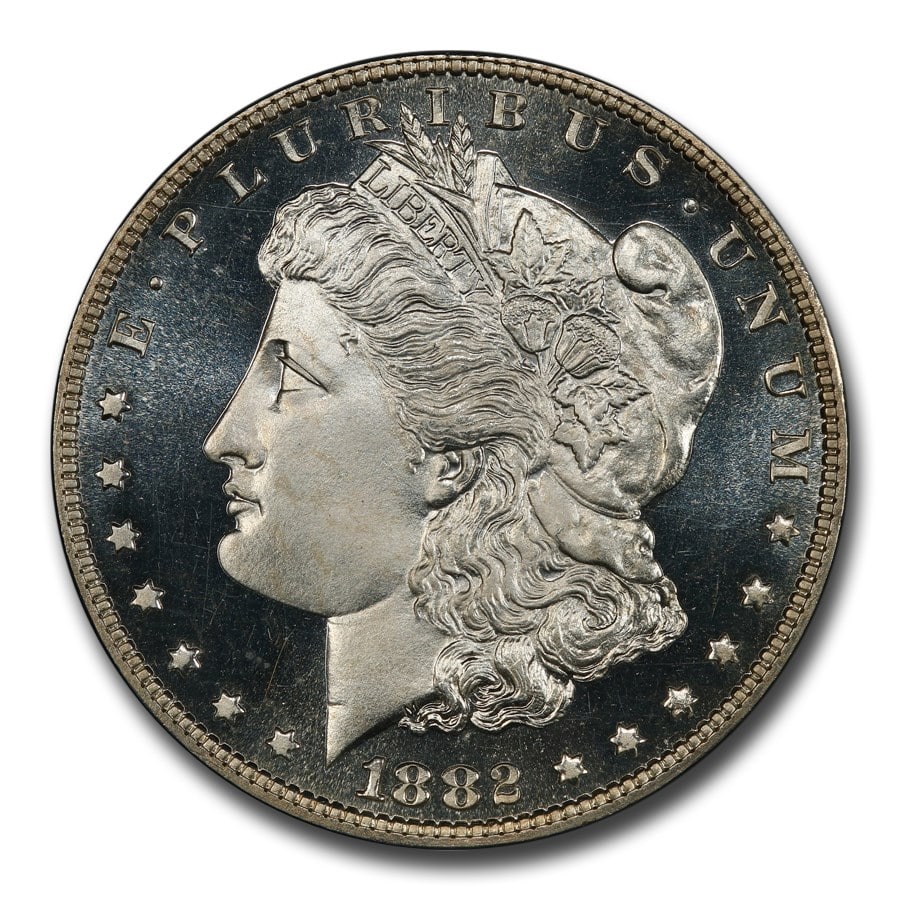

(An 1882 Morgan Silver Dollar, Proof, Obverse [left], Reverse [right].)
Peace Silver Dollars
After the end of World War I, which most people believed would never be eclipsed as the most horrendous tragedy the world had ever seen, there was a public cry for a coin, preferably a silver dollar, to commemorate the new “peace” in the world.
So, the Treasury Department invited numerous experienced artists to compete for a silver dollar design that would encompass the public’s desire for world peace. The winning artist was an Italian immigrant named Francesco de Francisci.
De Francisci used his wife, Teresa, as the model for the profile of Miss Liberty, as displayed on the coin. Miss Liberty faces left, wearing a crown with spikes radiating from it, like the Statue of Liberty, which influenced de Francisci. The word “LIBERTY” is prominent above her.
The reverse depicts an American Bald Eagle perched on a rock with the word “PEACE” conspicuously carved into the rock and numerous rays of sunshine in the background illuminating the eagle. The design was powerfully symbolic, depicting a broken sword that de Francisci intended to represent how the United States defeats its foes. Still, as broken swords are associated with the loser in a battle, it was removed from the final design.
These coins were first struck in 1921, so the United States had both 1921—dated Morgan and Peace Silver Dollars circulating simultaneously. These Peace Silver Dollars were struck until 1935, when the last of this series was minted.
Peace Silver Dollars are a very popular series to collect as all the coins can be found and are affordable in most grades, except in grades above MS-65. It is a nice set to complete. Common but circulated Peace Silver Dollars start at $35.00 and rise to $300.00 in Mint State.
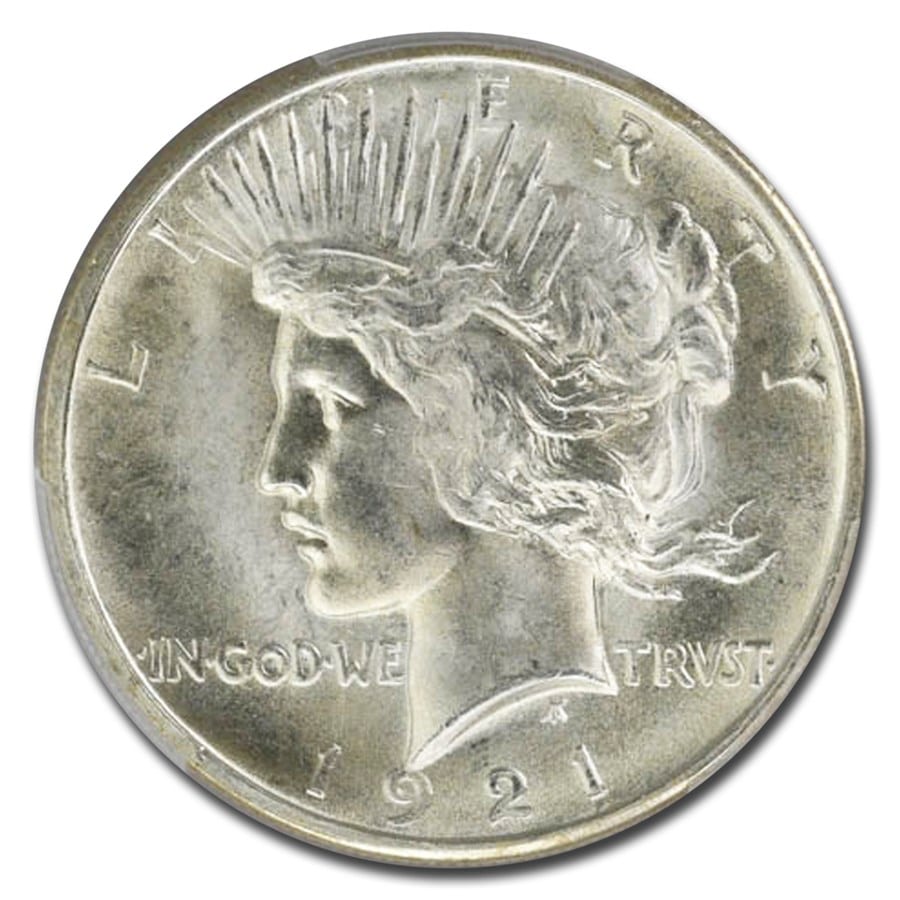
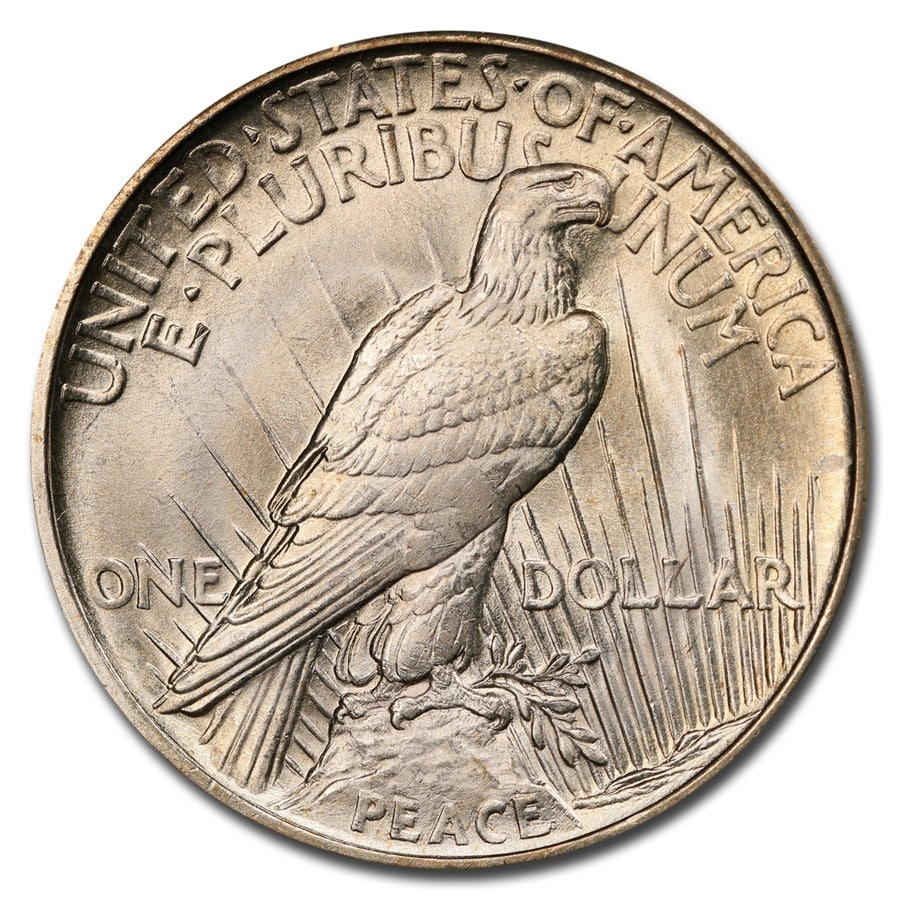
(A 1921 Peace Silver Dollar, First Year of Issue, Obverse [left], Reverse [right].)
Eisenhower Dollars
No silver dollar coins were struck after the Peace Dollars dated 1935. But in 1971, due to the death of former President Dwight Eisenhower, he was honored with his portrait on a silver dollar-sized coin. These “Ike” Dollars were struck as circulating coins in Copper-Nickel, the first dollar-sized coins not to be struck in silver.
The circulating coins struck at the Philadelphia and Denver Mints were struck in Copper-Nickel. The coins struck at the San Francisco Mint were struck in 40% Silver in both Uncirculated and Proof conditions.
Between 1971 and 1974, the obverse depicted a Dwight D. Eisenhower bust, while the reverse depicted an Eagle landing on our Moon with the Earth in the distant background. Also, between 1971 and 1974, the coins were struck at all three mints.
There were no Ike Dollars dated 1975 because of the country’s Bicentennial. The Bicentennial coins are dated 1776-1976. There are eight varieties of the Bicentennial Ikes, one of which is a unique specimen. The coin’s obverse was modified to display both dates, “1776 – 1976,” and the reverse depicted a picture of the Liberty Bell with the Moon in the background. Chief Engraver Frank Gasparro designed the coins.
The reverse reverted to the original Moon Landing design for the remaining years, 1977 and 1978. It is an easy set to complete except for that one unique strike.
Clad Ike Dollars start at around $3.00 and silver examples are about $25.00.
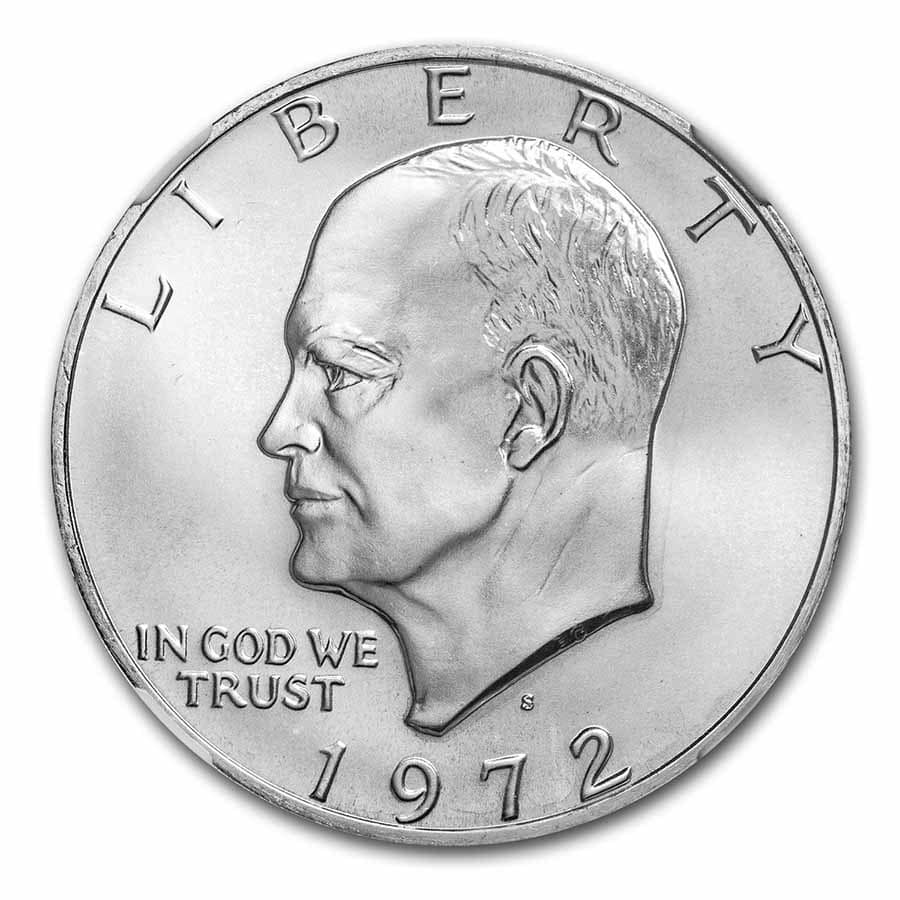
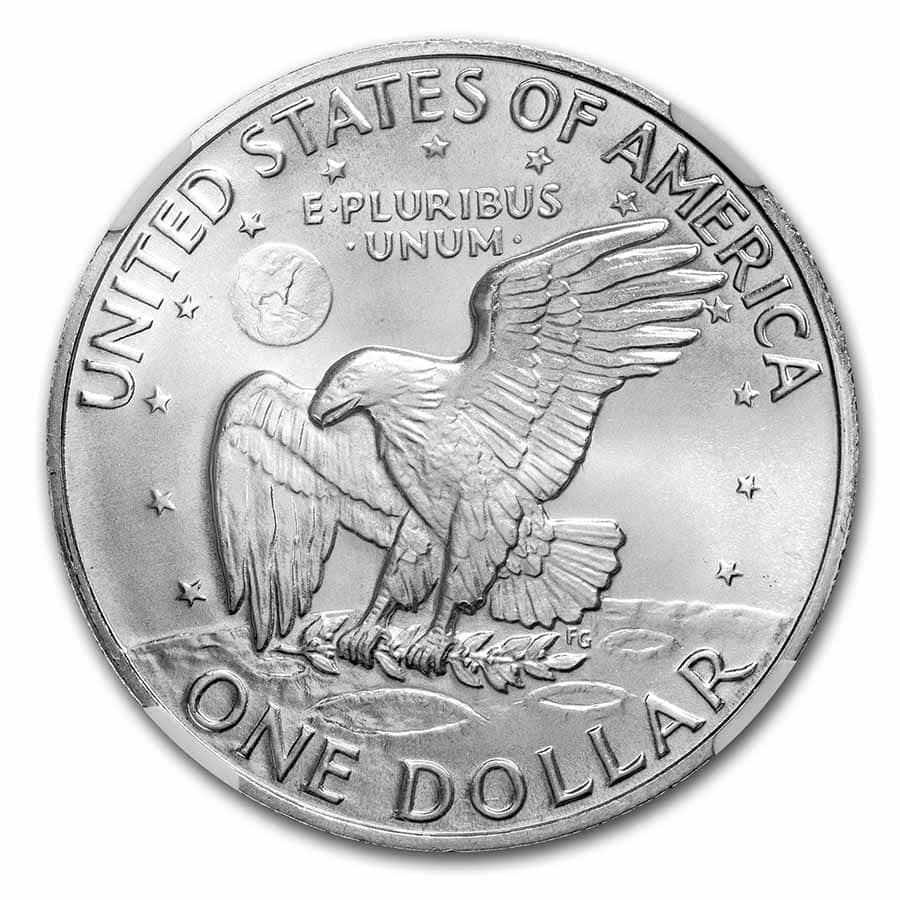
(A 1972-S Eisenhower Dollar, Silver, Obverse [left], Reverse [right].)
Small-Sized Dollars – Susan B. Anthony, Sacagawea, Presidential, Native American, and American Innovation
Susan B. Anthony Dollars
Between 1979 and 1981, the three mints – Philadelphia, Denver, and San Francisco – all struck copper-nickel dollar coins honoring Susan B. Anthony, a pioneer in women’s rights and the right for women to vote.
The obverse bore a portrait of Susan B. Anthony, while the reverse utilized the Moon Landing as depicted on Ike Dollars. Frank Gasparro, Chief Engraver of the U.S. Mint, also designed this coin. The coins were too similar in size to U.S. quarters and needed more use. The minting ceased in 1981 but was re-started for one year – 1999 – in anticipation of strong demand for the Sacagawea Dollar in 2000.
All Susan B. Anthony coins are available and affordable. Each date is affordable and easy to obtain. The values are from $5.00 to $25.00.

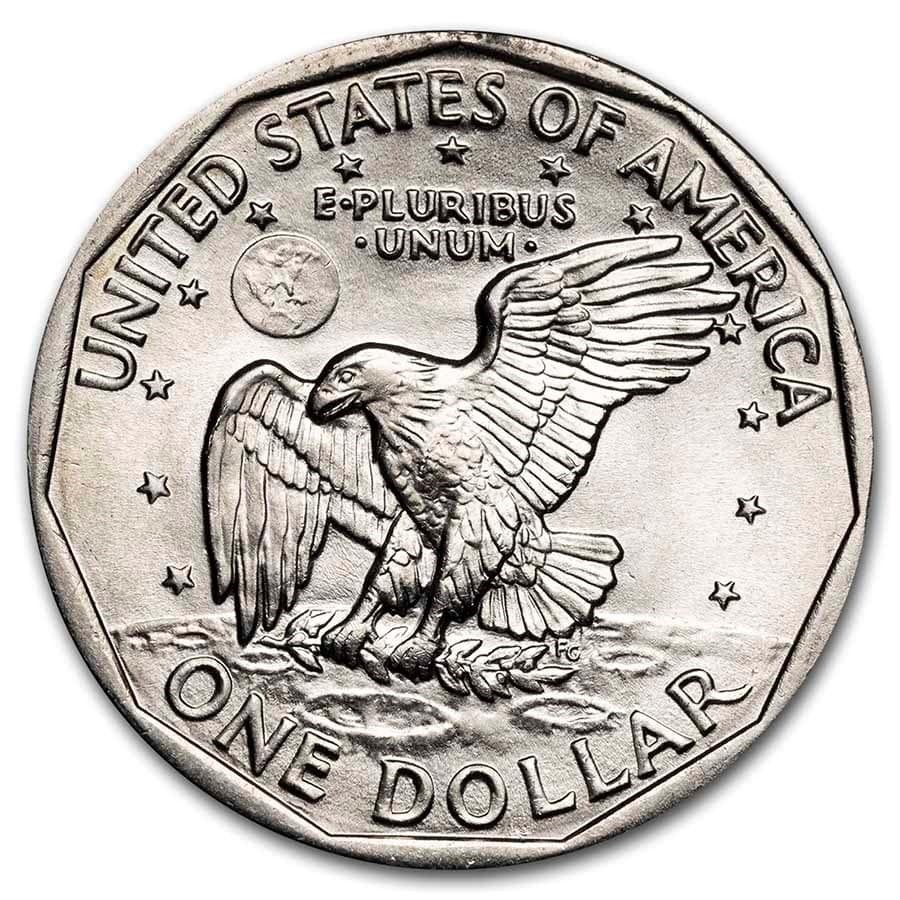
(A 1979 Susan B Anthony Dollar, Obverse [left], Reverse [right].)
Sacagawea Dollars
Between 2000 and 2008, the U.S. Mint struck dollar coins honoring Sacagawea. There was a national competition with the design by Glenna Goodacre winning. The obverse depicts Sacagawea carrying her son, Jean Baptiste. The coin’s reverse depicts an American Bald Eagle in flight, designed by the Mint Sculptor-Engraver Thomas D. Rogers, Sr. They were struck between 2000 and 2008.
To respond to complaints about the similarity in size of these small dollars to U.S. Quarters, the Mint used a distinctive golden color to differentiate them. But the American public still resisted using them for commerce. Most of these coins were used in vending machines or bought as souvenirs, but they were not the answer that the Mint had hoped to replace paper One Dollar certificates. Sacagawea Dollars are valued between $3.00 and $25.00.
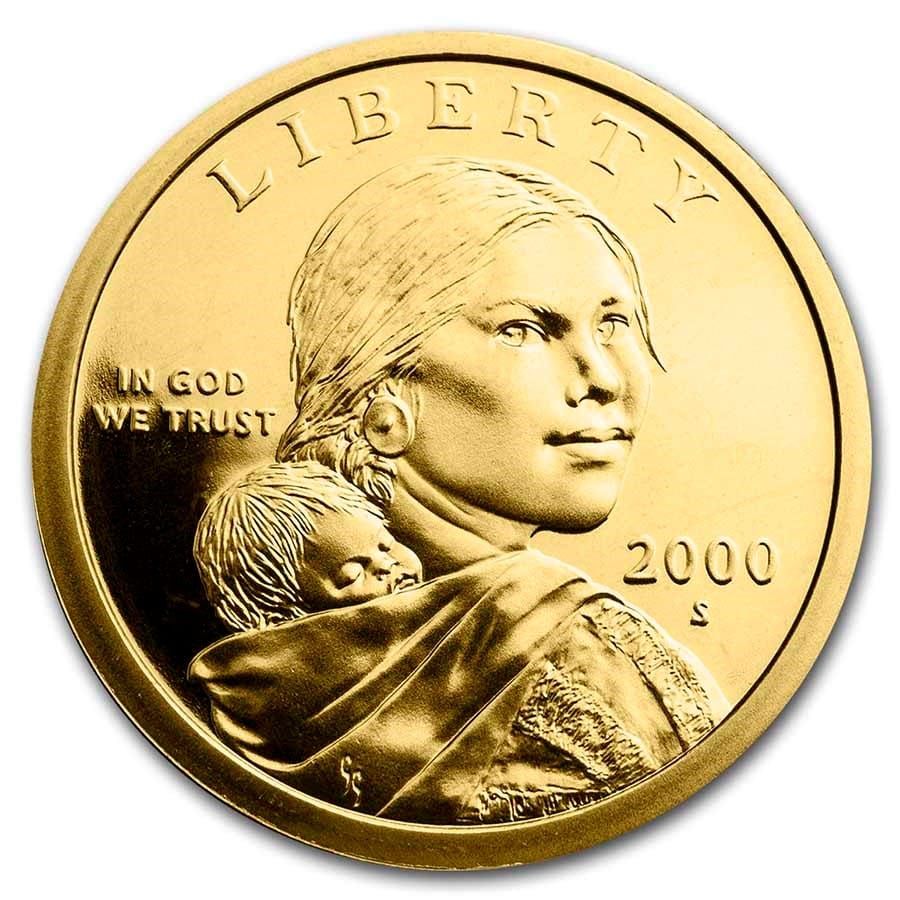
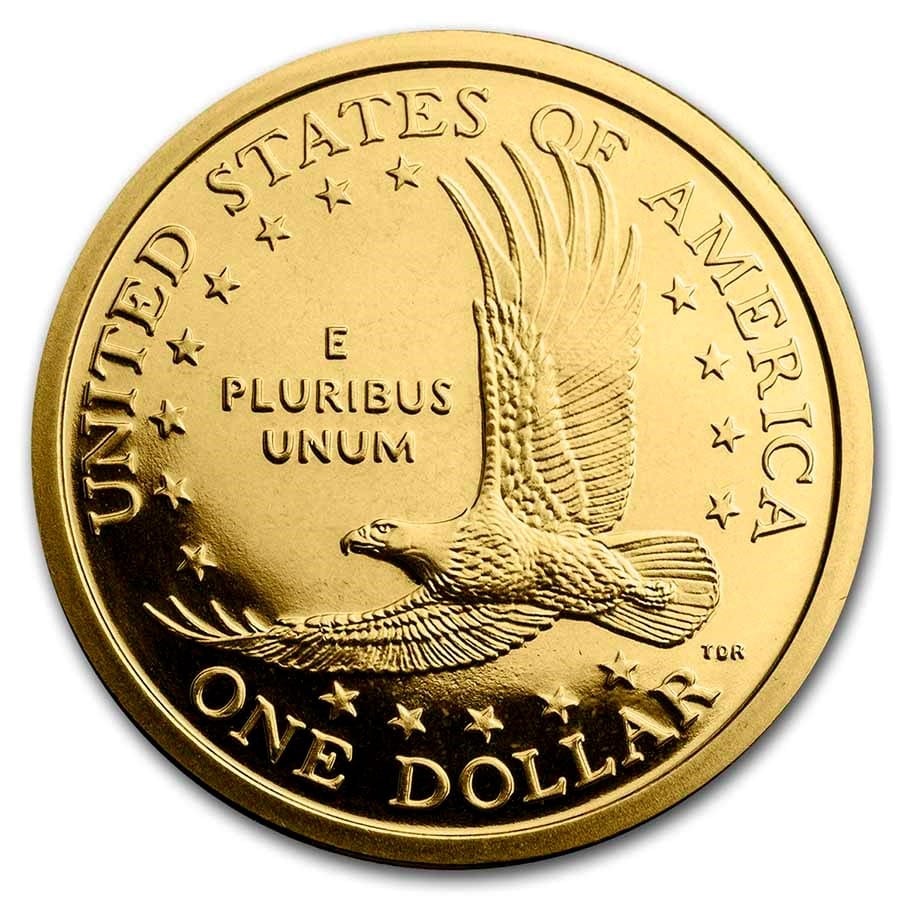
(A 2000-S Sacagawea Dollar, Proof, Obverse [left], Reverse [right].)
Presidential Dollars
The U.S. Mint struck a series of dollar coins depicting the U.S. Presidents between 2007 – 2016 and again in 2020. The coins issued illustrated portraits of American Presidents, in order, from George Washington through Ronald Reagan.
Presidents are only depicted on these coins once they have passed, so George H. W. Bush was honored with a coin in 2020. Former Presidents Bill Clinton, George W. Bush, Barack Obama, and Donald Trump have yet to have a coin struck for them. It is supposed that current President Biden will also be honored at the appropriate time.
Various artists designed the obverses, but they all utilize the Statue of Liberty as a standard reverse, designed by Don Everhart. These coins are companions to the First Spouse Half Ounce gold coins.
Other than coins with striking or on-edge lettering errors, the Presidential Dollars are available slightly over face value. Values are from $3.00 to about $10.00.
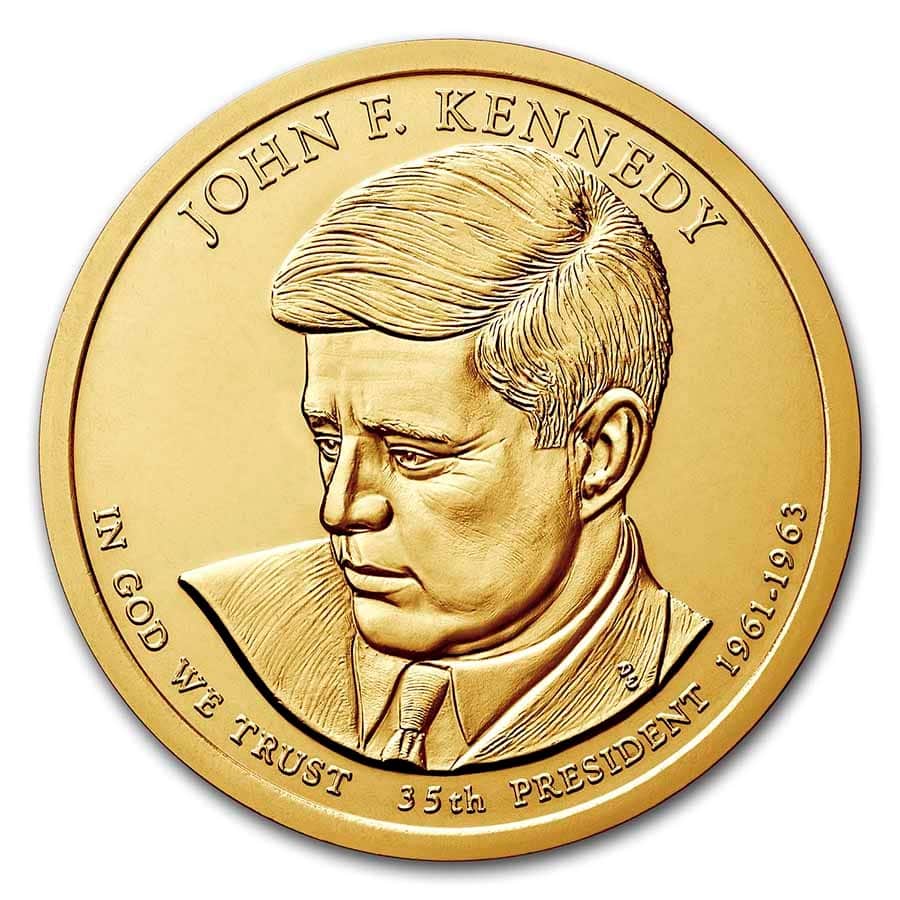
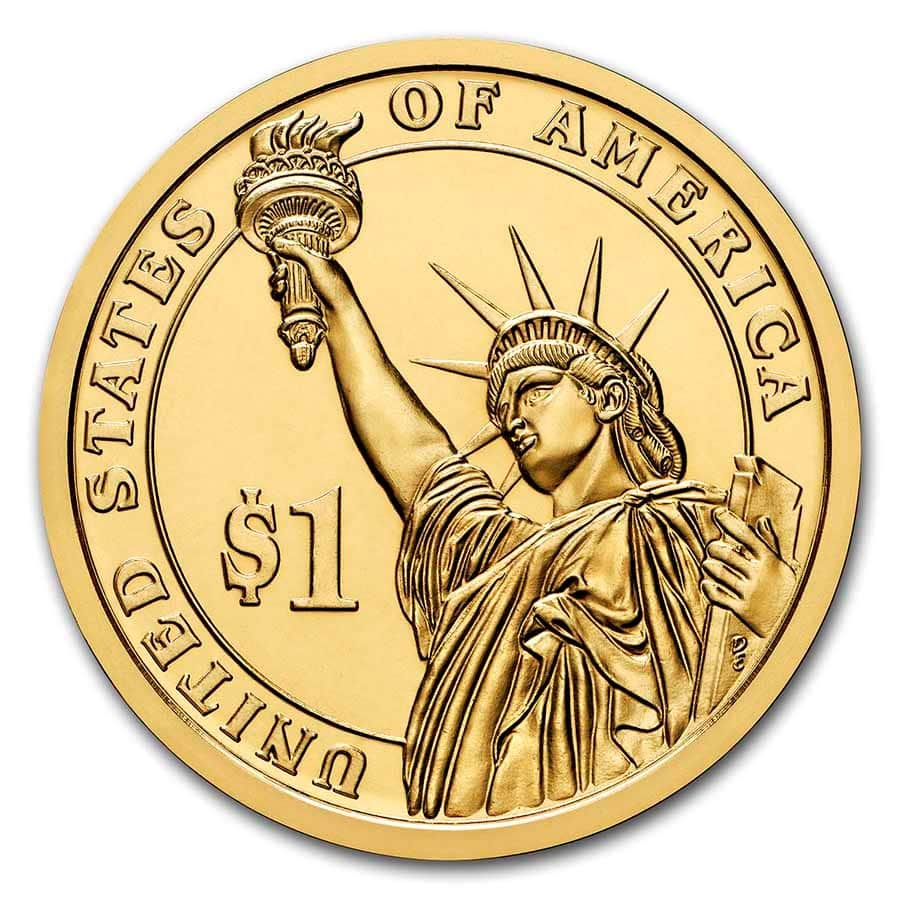
(A 2015-P JFK Presidential Dollar, Obverse [left], Reverse [right].)
Native American Dollars
The Native American Dollar Series began in 2009 and continues through the current year. The coins all feature the Sacagawea obverse, but each reverse differs and depicts many different accomplishments by Native Americans or important events in their history.
Since 2011, all coins have been offered as numismatic offerings and not released for general circulation. The coins’ size and composition are identical to the Sacagawea Dollar. Their values range from $3.00 to under $20.00 for single specimens.
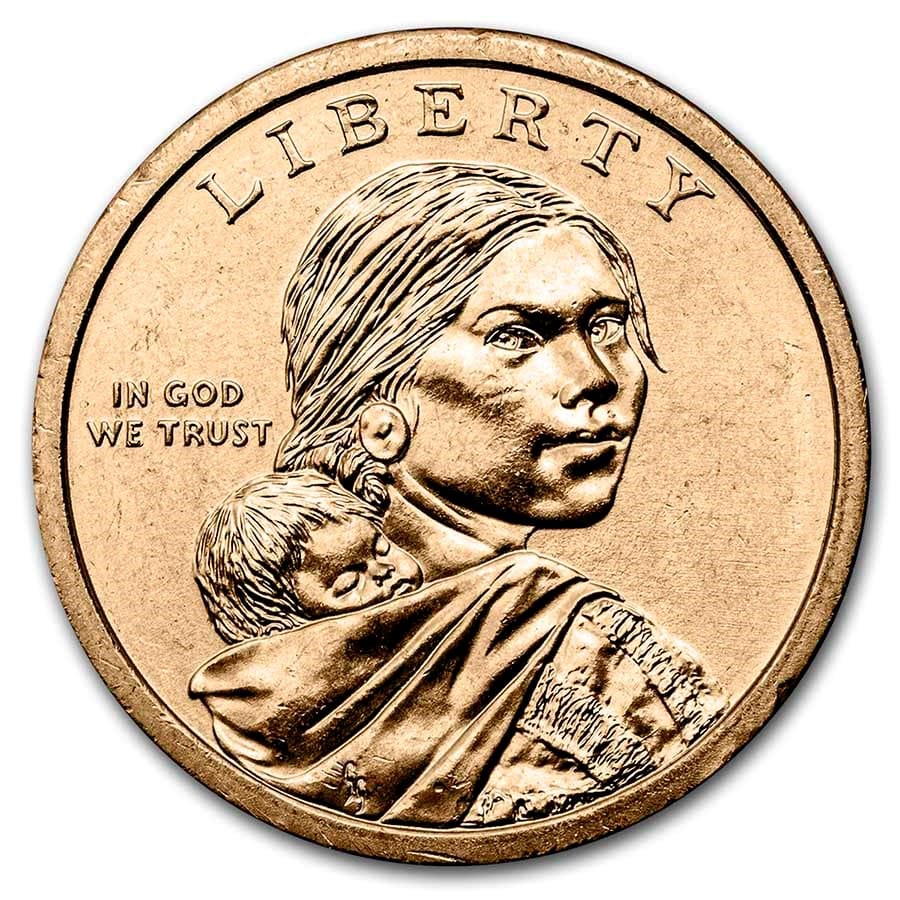
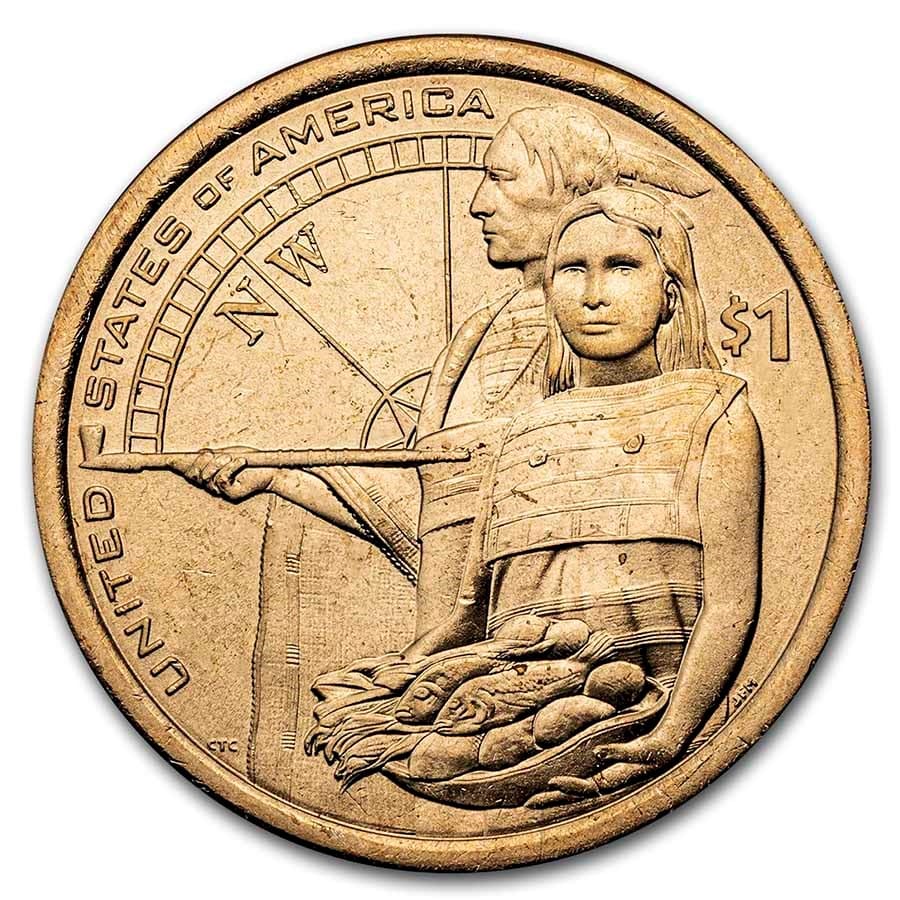
(A 2014-D Native American Dollar, Native Hospitality, Obverse [left], Reverse [right].)
American Innovation Dollars
The American Innovation Dollar Series began in 2018 and will run through 2032, with four coins issued yearly. The coins symbolically portray the American traits of exploration, discovery, innovation, and destiny.
The coins share a common obverse depicting the Statue of Liberty as designed by Justin Kunz. In contrast, the reverse designs differ and were done by many artists, generally from the state of issue but not always. The individual states do have significant input into the subject matter and designs.
The coins were not released for general circulation but are available through the U.S. Mint and coin dealers. The individual values are from $2.00 to $20.00 each.
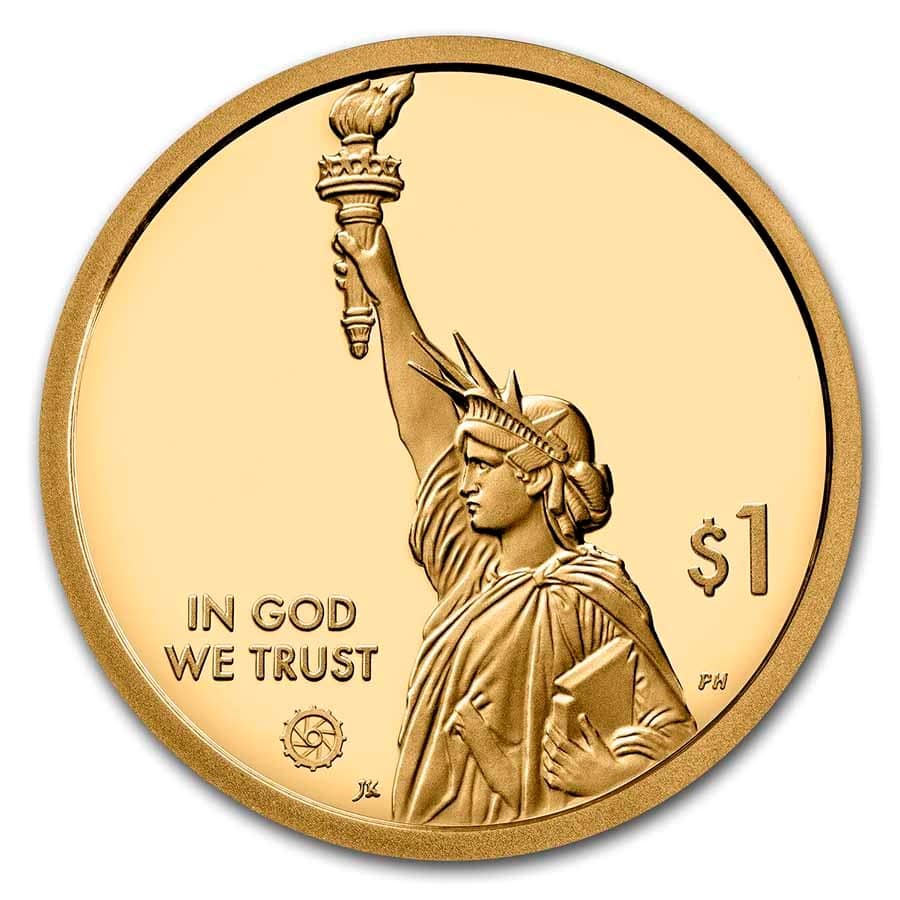

(A 2021-P American Innovation Dollar featuring North Carolina, Obverse [left], Reverse [right].)
An outstanding collection of United States One Dollar Coins could include one of each of the general types of dollar coins listed here from 1794 through 2023.




